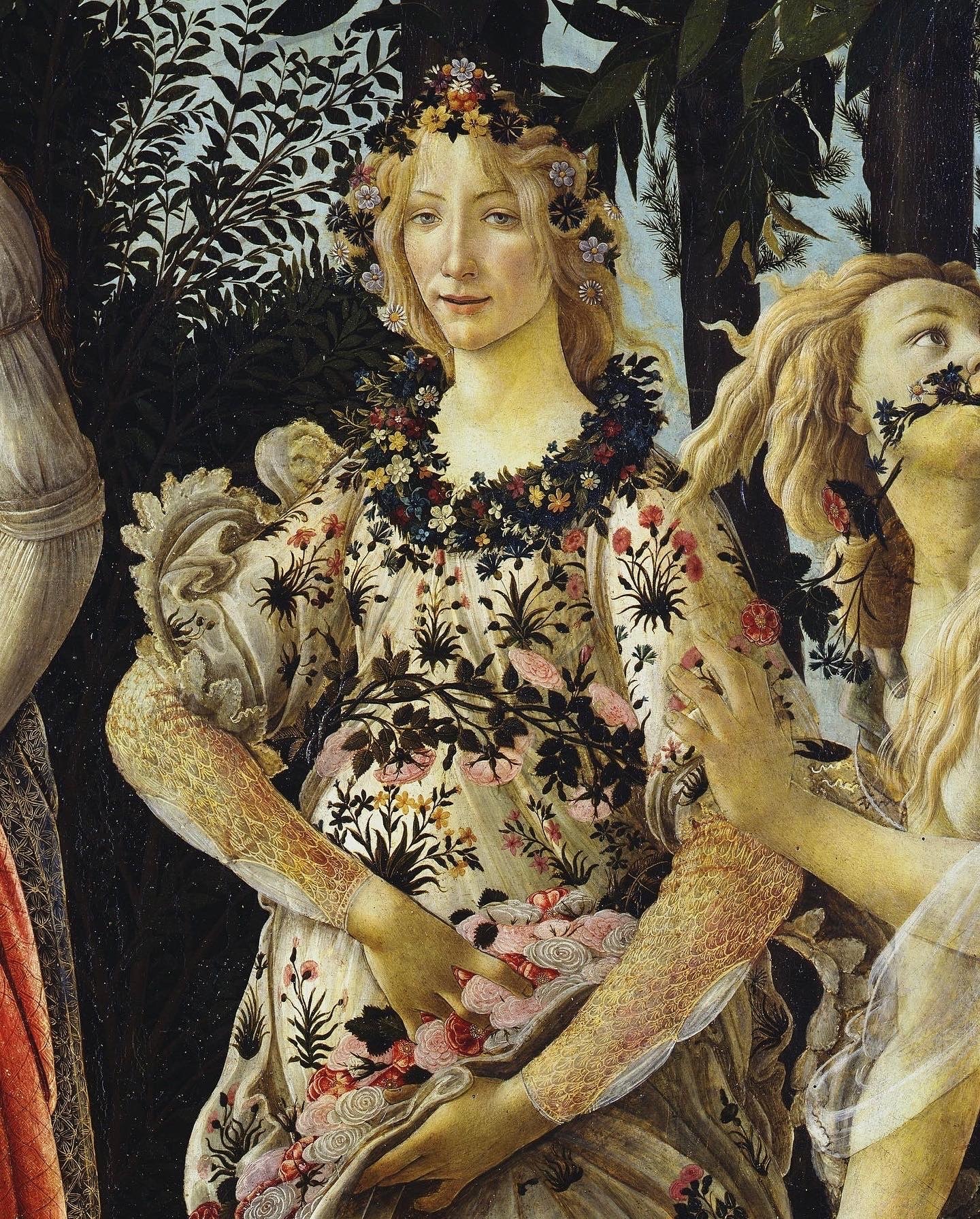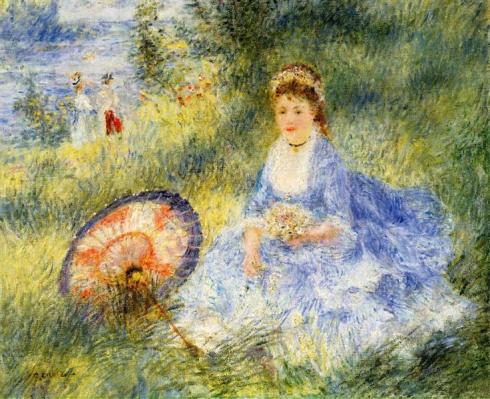“O come! (…) The rose is full blown,
The riches of Flora are lavishly strown…”
 Sandro Botticelli, Primavera, tempera on panel, c.1482
Sandro Botticelli, Primavera, tempera on panel, c.1482
These days I was really enjoying Botticelli’s painting “Primavera”; and I took great delight in gazing at all the details and especially gazing at the figures of Flora and the nymph Chloris caught in the wicked embrace of the God Zephyr. This painting needs no introduction because it is so famous in the Western world, but I still felt the need to share its beauty here and to show my appreciation, or rather, adoration. Sandro Botticelli was one of the Medici family’s favourite painters at the time and this painting was probably painted for the occassion of the marriage of Lorenzo Medici’s cousin which took place in 1482 and that is the date usually asigned to the painting. The painting’s themes of love and new beginnings, tied with the arrival of spring, as personified by the Roman Goddess Flora, are fitting for such a happy occassion indeed.
The court poet of the Medici family, Angelo Poliziano, described the garden of Venus as a place of eternal spring and peace, and his descriptions may have served as an inspiration to Botticellli for this painting. As the title “Primavera” suggests, the painting shows the arrival of spring and the celebrations surrounding the event. The arrival of spring is the most joyous time of the year for me! Who would not wish to celebrate it!? For long winter months I yearn to see the flowers blooming, the weeping willows coming alive with many little leaves, the birds singing… It is natural then, that the arrival of spring and the entire season of spring is also tied with the season of love. The central figure in Botticelli’s painting is Venus, the Goddess of Love, in the company of of her son Amor who is flying above her with his love arrows, and the Three Graces, dressed in flimsy white dresses that reveal more than they conceal. Venus is in the centre of the composition but, compared to the other figures, she is standing more in the background, as if she is allowing the spring to come before her. In the far right corner is the God Mercury who is holding off a rainy cloud with his stick; nothing is allowed to disturb the idyll of the beautiful garden where orange trees are ripe with fruit and a sweet fragranace of flowers colours the air. The Roman poet Lucretius’ poetic work “De Rerum Natura” may have also served as an inspiration to Botticelli and indeed in some of the verses we find similarities:
“Spring-time and Venus come, and Venus’ boy,
The winged harbinger, steps on before…
Sprinkling the ways before them, filleth all
With colours and with odours excellent…”

It is as if Botticelli is describing these verses because most of the characters from the painting are here in the poem; the Venus and her ‘boy’, Zephyr and Flora. My favourite part of the painting is the right corner where we have an interesting motif of metamorphosis presented all in one painting, although it doesn’t happen at the same time. Zephyr, the God of Wind, is seen forcefully embracing the beautiful yet frightened nymph Chloris who then transforms into the Goddess Flora who is represented by the woman dressed in a long white gown decorated with little flowers, for she is the Goddess of spring. A woman touched by love becomes all flowery and spring-like; what a beautiful analogy! Here are more verses from Lucretius’s “De Rerum Natura”:
“For thee waters of the unvexed deep
Smile, and the hollows of the serene sky
Glow with diffused radiance for thee!
For soon as comes the springtime face of day,
And procreant gales blow from the West unbarred,
First fowls of air, smit to the heart by thee,
Foretoken thy approach, O thou Divine,
And leap the wild herds round the happy fields
Or swim the bounding torrents. Thus amain,
Seized with the spell, all creatures follow thee
Whithersoever thou walkest forth to lead,
And thence through seas and mountains and swift streams,
Through leafy homes of birds and greening plains,
Kindling the lure of love in every breast,
Thou bringest the eternal generations forth…”
This “transformation by love” that has happened between Zephyir and Flora is the most beautiful element of the painting for me. Also, I am really enjoying Flora’s fashion choice; the long white gown and flowers. Flora as imagined by Botticelli made me think of a few fashion pictures from the sixties and seventies, and also of the costume worn by the sweet Jane Birkin.




Jane Birkin in “Wonderwall” (dir. Joe Massot – 1968)

Detail

ELLE Magazine – July 7th 1975 Yves Saint Laurent and Liberty of London Photographed by Barry Lategan

Toni Frissell – Vogue (June 1967)
Tags: 1482, 1960s, 1970s, Angelo Poliziano, art, art blog, Beauty, Botticelli, celebration, Chloris, court, De Rerum Natura, fashion, Flora, floral, flowers, garden, groovy, Italian Art, Italian painter, Jane Birkin, love, Lucretius, Medici, Nature, Painting, Primavera, Renaissance, Roman mythology, Spring, wedding, Wonderwall (1968), Zephyr
 Renoir, Young Woman with a Japanese Umbrella, 1876
Renoir, Young Woman with a Japanese Umbrella, 1876










